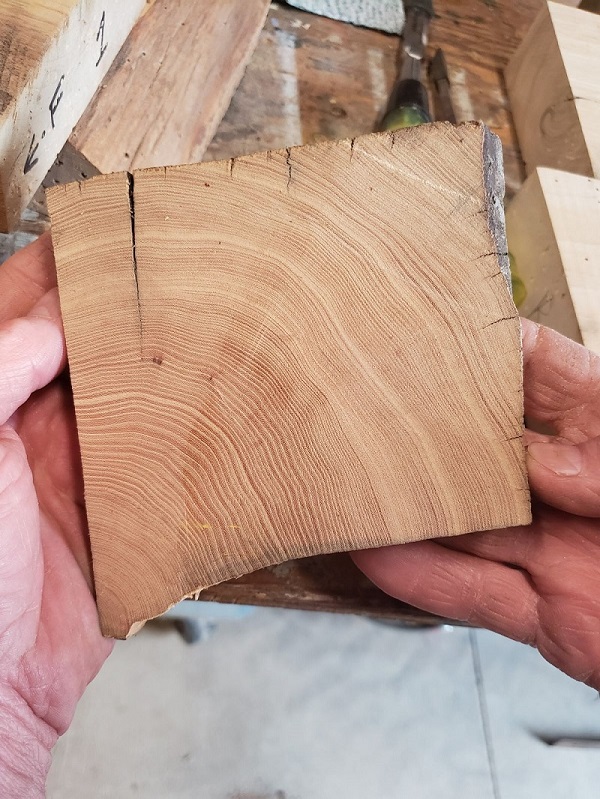Reclaimed Barnwood is Truly One-of-A-Kind
Here are some of the things that set it apart from the wood at your local hardware store
If you follow woodworkers, carpenters, or reclaimed barnwood companies on Instagram, there's a good chance you've seen photos like these- the ones with old growth wood contrasted with new growth wood.
And, chances are, at some point you've looked at it, raised your eyebrows, and said something along the lines of "dang, that's cool." It is absolutely wild seeing the difference between old growth and new growth wood you can purchase from your local hardware store.
We talk about how incredible reclaimed barnwood is, about why it is worth the investment. That's not something we just made up one day and then decided to run with. There are some distinct differences between reclaimed wood and something you can get at a hardware store.
So, for starters, the wood we salvage from barns is considered old growth wood. But what exactly makes something old growth?
What Makes Wood Old Growth?
The Department of Natural Resources defines an old growth forest as one that has developed over a long period of time. And by a long time, we're talking at least 120 years. The wood used to build barns and other structures that we now reclaim can sometimes come from trees that were 200 to 400 years old.
There aren't many old growth forests left, and the ones that are considered old growth are typically protected because they have become home to threatened plant and animal species. The most well-known old growth forests are the ones in the Pacific Northwest, like the redwoods or giant sequoias, but there are actually a few in Michigan.

The wood that is available to purchase in stores right now is considered to be new growth. This wood comes from lumber farms, which began popping up as the resources in natural, old growth forests became significantly more depleted. These lumber farms grow fast-growing trees, like pine, as a way to keep up with demand.
What Makes Old Growth Wood Better?
Well, other than the amount of time the tree is able to grow, there are a few other things that set old growth wood apart. The longer a tree is able to grow and develop, the stronger and more dense its wood becomes. As kids, I think we all looked at the rings of a tree and maybe even tried to count them to tell its age. The older the tree, the more rings it has. And the tighter the rings of a tree are packed, the more dense the timber will be. That tighter wood grain comes specifically from old growth trees, such as oak, maple, and walnut, which are honestly not as readily available anymore, if at all.
If you're wondering why wood density even matters, well, that increased density means there is less of a chance of splintering, splitting, and warping. Plus, the wood itself is much sturdier, so not only can it hold more weight, it also does not expand and contract as much when exposed to moisture.
Additionally, the slow growth rate of old growth wood actually makes it more resistant to rotting. During the late summer and fall, the cells that are grown are smaller and more dense. That layer of wood is called latewood and it signifies the end of the growing season. The more complete growing seasons a tree is able to complete, the more latewood layers a tree has. Because the latewood consists of smaller and more dense cells, it is much more resistant to rot.

And That's Why We Love Reclaimed Barnwood
There are a ton of scientific reasons why old growth wood is significantly better than new growth wood. But it's more than just that. This old growth wood means less likelihood of rotting, it is much stronger, and it's not as likely to warp- meaning less movement and longer-lasting paint jobs. That's honestly the reason why we are able to salvage and use wood from 100 to 200+ year old barns. It is of such high quality that it can be repaired and restored, lasting another 100 years. Even though the outside of the wood may appear to be in bad shape- I mean, many of the barns we deconstruct are dilapidated- the wood inside can still be in excellent condition.
So, we reclaim lumber, doors, beams, and other materials from these old barns, using them in projects and installations today. The wood is strong and dense and can be in excellent condition, making it the environmentally friendly option when starting a new woodworking project or dreaming up a home remodel or renovation.
If you didn’t know before, now you do- share it with your friends. Reclaimed barn wood (old growth wood) is higher quality and superior to the new growth wood available at most hardware stores. Reduce your impact by reusing barn wood. Elevate the quality of your project with high quality woods. And capture a piece of history with your custom wood furniture.
Want to know more? Check out our YouTube channel. We post the occasional video about woodworking and reclaimed barnwood.
Have questions? We now have a new place for you to ask questions... And Jim will answer them!